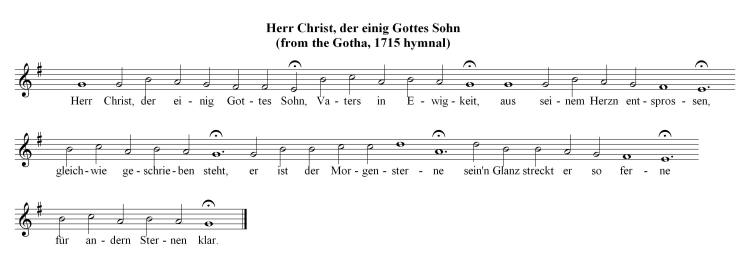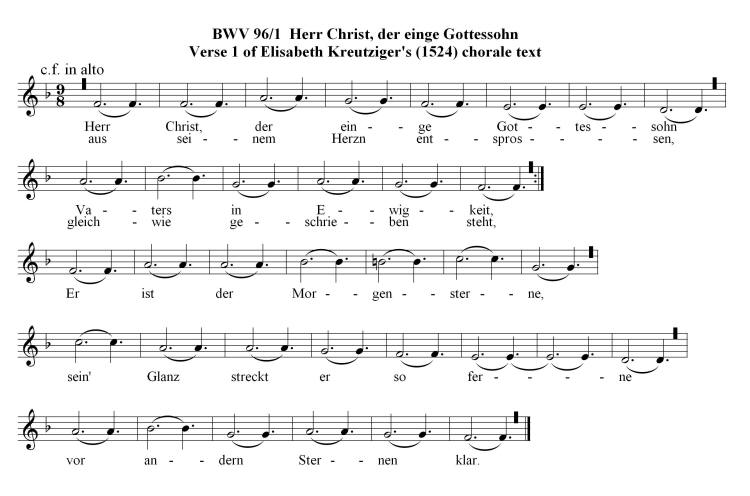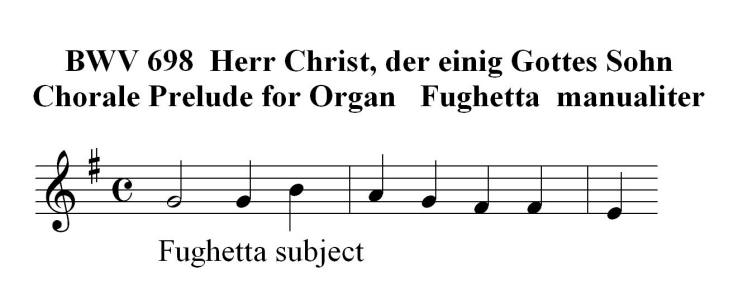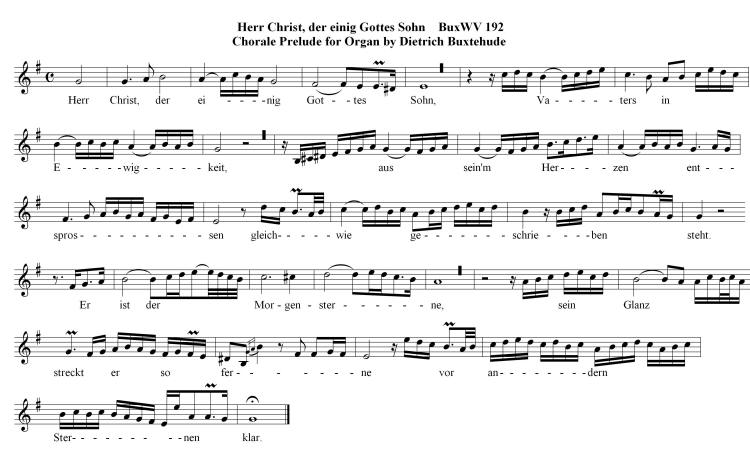|
Chorale Melodies used in Bach's Vocal Works
Herr Christ, der einge Gottessohn [1]
|
|
Melody & Text | Use of the CM by Bach | Use of the CM by other composers | Arrangements/Transcriptions | Footnotes |
| |
|
Melody & Text: Zahn: 4297a | EKG: 46 |
|
Text: |
|
By Elisabeth Kreuziger/Creutziger (1524).
The text is based upon the Latin Christmas hymn by Aurelius Prudentius, Corde natus ex parentis. Also, it is the first Reformation chorale to draw on the late medieval tradition of Jesus mysticism that became prominent in succeeding generations. |
|
>> Luther’s practice was also that of his immediate collaborators, whose chorales appeared with Luther’s in the earliest printed collections, and who together formed the ‘Wittenberg orbit’, named after the centre of Luther’s activities from 1512. Many of their chorales are still sung, notably Wo Gott der Herr nicht bei uns hält (EG 297) by Justas Jonas; Es ist das Heil uns kommen her (EG 342) by Paul Speratus; Ich ruf zu dir, Herr Jesu Christ (EG 343), sometimes attributed to Johann Agricola (c1494-1566); Johann Walter’s Wach auf, wach auf, du deutsches Land (EG 145); Erasmus Alber’s Christe, du bist der helle Tag (EG 469), based on the hymn Christe qui lux es et dies; Nun lob, mein Seel, den Herren (EG 289) by Johann Gramann (1487-1541) and Herr Christ, der einig Gotts Sohn (EG 67) by Elisabeth Cruciger (c1500-1535), the first Reformation chorale to draw on the late medieval tradition of Jesus mysticism that became prominent in succeeding generations (The melody of this chorale is derived from a mid-15th-century secular love song, Mein Freund möcht sich wohl mehren, in the Lochamer Liederbuch, and its text is based on the Christmas hymn of Aurelius Prudentius, Corde natus ex parentis.) Allein Gott in der Höh sei Ehr (EG 179) and O Lamm Gottes, unschuldig (EG 190.1) by Nikolaus Decius are important as versifications of the Gloria and Agnus Dei that are set to the original Gregorian melodies. Although Luther, for personal reasons, never included Decius’s chorales in the official Wittenberg hymnbooks, they soon became part of the standard German Mass Ordinary cycle.<<
Authors: Robert L. Marshall/Robin A. Leaver in Grove Muisc Online © Oxford University Press 2006, acc. 5/21/06
|
| |
|
Melody: |
|
This chorale melody began its existence as a secular song Mein Freud möcht sich wohl mehren [“My joy will most likely increase” or “My joy is already increasing”] contained in Wolflin Lochamer’s collection of secular songs printed in Nürnberg around 1455. It was modified by Elisabeth Kreuziger for its first appearance as a sacred song/chorale (a contrafact) in Geystlich Gesangk Buchleyn (edited by Johann Walter) which was printed in Wittenberg in 1524. |
| |
|
Early sources: |
|
The original, earliest printing of the melody with a setting by Johann
Walter appears this way: |
 |
|
A possibly late 15th or early 16th century version of the melody: |
|

|
|
A possibly late 16th century version of the melody: |
|

|
| |
|
Hymnal versions Bach may have known: |
|
A version of the melody in a hymnal (Gotha, 1715) with which Bach was most likely acquainted: |
|

|
| |
|
Use of the Chorale Melody by Bach: |
|
Text: Herr Christ, der einge Gottessohn | EKG: 46
Author: Elisabeth Kreuziger (1524) |
|
Ver |
Work |
Mvt. |
Year |
Br |
RE |
KE |
Di |
BC |
Score |
Music Examples |
|
5 |
BWV 22 |
Mvt. 5 |
1723 |
- |
- |
- |
- |
A99:5 |
- |
Mvt. 5 (Leusink) [ram] |
|
1 |
BWV 96 |
Mvt. 1 |
1724 |
- |
- |
- |
- |
A142:1 |
- |
Mvt. 1 (Leusink) [ram] |
|
5 |
BWV 96 |
Mvt. 6 |
1724 |
302 |
128 |
303 |
92 |
A142:6 |
PDF |
Mvt. 6 (MG) [midi] | Mvt. 6 (Leusink) [ram] |
|
5 |
BWV 132 |
Mvt. 6 |
1715 |
- |
- |
- |
- |
A6:6 |
- |
Mvt. 6 (Leusink) [ram] |
|
5 |
BWV 164 |
Mvt. 6 |
1725 |
101 |
127 |
101 |
82 |
F81
A128:6 |
PDF |
Mvt. 6 (MG) [midi] | Mvt. 6 (Leusink) [ram] |
|
BWV 132/6 (1715): a setting of verse 5 of Elisabeth Kreuziger’s (1524) CT Herr Christ, der einge Gottessohn is called for at this point in the libretto, but Alfred Dürr believes that there is no missing chorale setting and that Bach may have intentionally dropped the idea of performing a chorale at this point. The NBA does not include it because the actual music for that specific occasion is either lost or was never composed (as Dürr indicated). Nevertheless, all the recordings of Cantata BWV 132, which have been released so far (May 2006), include this mvt.
the setting of which is derived from one of the other existing settings listed
above. |
|

|
|

|
|

|
|

|
| |
|
Untexted: |
|
Ver |
Work |
Mvt. |
Year |
Br |
RE |
KE |
Di |
BC |
Score |
Music Examples |
|
- |
BWV 601 |
- |
1713/15 |
- |
- |
- |
- |
K30 |
- |
- |
|
- |
BWV 698 |
- |
1700/17 |
- |
- |
- |
- |
K149 |
- |
- |
|
BWV 601: Orgelbüchlein No. 3. [2]
BWV 698: Fughetta for Organ. |
|

|
|

|
| |
|
Alternate Text: Herr Gott, nun sei gepreiset |
|
[2] BWV 601 Bach has indicated a second text that could also be sung to the above melody; however, Bach never set this specific text to music other than this secondary reference given here.
Herr Gott, nun sei gepreiset,
wir sagen frohen Dank,
daß du uns Gnad’ erwiesen,
gegeben Speis’ und Trank,
dein mildes Herz zu merken,
den Glauben uns zu stärken,
daß du seist unser Gott.
This 1st verse supplied by C.S.Terry, “Bach’s chorals…” 1921 as it first appeared in Bapst’ hymnbook of 1553 and was sung to this melody from at least by 1609. |
| |
|
Use of the Chorale Melody by other composers: |
|
Hans Leo Hassler (1564-1612):
Herr Christ, der einig Gott's Son, setting for 4 voices (1608) |
|
Johann Hermann Schein (1586-1630):
Herr Christ der einig Gotts Sohn, SATB [bc] (1627)
Herr Christ der einig Gottes Sohn, SS, bc (1618) |
|
Samuel Scheidt (1587-1654):
Herr Christ, der einig Gotts Sohn, 4-pt setting, SSWV 487 (Görlitz, 1650) |
|

|
|
Melchior Schildt (1592/1593-1667):
Herr Christ, der einig Gotts Sohn, Chorale Prelude for Organ (all five verses are set) |
|
Johann Heinrich Scheidemann (1595-1663):
Herr Christ, der einig Gottes Sohn, 2 Chorale Preludes for Organ (one of these is marked anonymous, but it probably by Scheidemann
nevertheless) |
|
Johann Balthasar Erben (1626-1686):
Herr Christ, der ein’ge Gottes Sohn, Cantata for 5 voices, 5 instruments, bc |
|
Sebastian Knüpfer (1633-1676):
Herr Christ, der einig Gottes Sohn, Cantata for 5 voices, 2 violins, 3 violas, bassoon, 2 cornetts, 3 trombones, and organo |
|
Dietrich Buxtehude (c1637-1707):
Herr Christ der einig Gottes Sohn, Chorale Prelude for Organ in G major, BuxWV 191
Herr Christ der einig Gottes Sohn, Chorale Prelude for Organ in G major, BuxWV 192 |
|

|
|
Johann Michael Bach (1648-1694):
Herr Christ, der einig Gottes Sohn, Chorale Prelude for Organ |
|
Johann Pachelbel (1653-1706):
Herr Christ, der einig Gott’s Sohn, Chorale Prelude for Organ |
|

|
|
Christian Friedrich Witt (1660-1716):
Herr Christ, der einig Gottessohn, Chorale Prelude for Organ |
|
Georg Friedrich Kauffmann (1679-1735):
Herr Christ, der einig Gottessohn, Chorale Prelude for Organ |
|

|
|
Georg Philipp Telemann (1681-1767):
Cantata: Herr Christ, der einge Gottessohn (I) (Erdmann Neumeister libretto), for SATB, strings, bc, TVWV 1:732 (1722) [this was formerly BWV Anhang III, 156]
Sacred Cantata: Herr Christ, der einge Gottessohn (II) (Erdmann Neumeister libretto), for SATB, 2 recorders, 2 oboes, strings & continuo, TWV 1:733 (1758) |
|
Johann Gottfried Walther (1684-1748):
Herr Christ, der einig Gottes Sohn, Chorale Prelude for Organ |
|

|
|
J.S. Bach (Doubtful):
Herr Christ, der einig Gottes Sohn (II), Chorale Prelude for Organ (doubtful), BWV Anh. 2/55
Herr Christ, der einig Gottes Sohn (III), Chorale Prelude for Organ (Rinck Collection), BWV deest
Herr Christ, der einig Gottessohn, Chorale Partita for Organ (doubtful), BWV Anh 77 |
| |
|
Arrangements/Transcriptions of Bach's use of the Chorale Melody: |
|
Walter Rummel (1887-1953):
Piano transcription of the chorale Ertoedt’ uns durch dein’ Güte (Mvt. 5) from Cantata BWV 22 |
|
See list of Piano Transcriptions of BWV 22/5 by various composers/arrangers at:
Piano Transcriptions of Bach's Works - Index by BWV Number Part 1: Cantatas |
|
See list of Piano Transcriptions of BWV 601 & BWV 698 by various composers/arrangers at:
Piano Transcriptions of Bach's Works - Index by BWV Number Part 4: Chorale Preludes for Organ |
| |
|
Footnotes |
|
[1] In more modern German versions of this title (after the 16th century), the "einge“ is often changed to "einig“ and sometimes “Gottessohn” is separated to become “Gottes Sohn” or even “Gotts Sohn”. |
| |
|
Sources: NBA, vols. III/2.1 & 2.2 in particular [Bärenreiter, 1954 to present] and the BWV ("Bach Werke Verzeichnis") [Breitkopf & Härtel, 1998]
The PDF files of the Chorales were contributed by Margaret Greentree J.S. Bach Chorales
Software: Capella 2004 Software, version 5.1.
Prepared by Thomas Braatz & Aryeh Oron (May
2006, March 2008) |